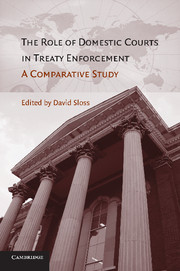Book contents
- Frontmatter
- Contents
- Contributors
- Preface
- Acknowledgments
- 1 Treaty Enforcement in Domestic Courts: A Comparative Analysis
- 2 Does International Law Obligate States to Open Their National Courts to Persons for the Invocation of Treaty Norms That Protect or Benefit Persons?
- 3 Australia
- 4 Canada
- 5 Germany
- 6 India
- 7 Israel
- 8 The Netherlands
- 9 Poland
- 10 Russian Federation
- 11 South Africa
- 12 United Kingdom
- 13 United States
- 14 The Role of Domestic Courts in Treaty Enforcement: Summary and Conclusions
- Index
- References
1 - Treaty Enforcement in Domestic Courts: A Comparative Analysis
Published online by Cambridge University Press: 06 January 2010
- Frontmatter
- Contents
- Contributors
- Preface
- Acknowledgments
- 1 Treaty Enforcement in Domestic Courts: A Comparative Analysis
- 2 Does International Law Obligate States to Open Their National Courts to Persons for the Invocation of Treaty Norms That Protect or Benefit Persons?
- 3 Australia
- 4 Canada
- 5 Germany
- 6 India
- 7 Israel
- 8 The Netherlands
- 9 Poland
- 10 Russian Federation
- 11 South Africa
- 12 United Kingdom
- 13 United States
- 14 The Role of Domestic Courts in Treaty Enforcement: Summary and Conclusions
- Index
- References
Summary
International law today is not confined to regulating the relations between the states. Its scope continues to extend. Today matters of social concern, such as health, education, and economics apart from human rights fall within the ambit of international regulations. International law is more than ever aimed at individuals.
This book presents a comparative analysis of the role of domestic courts in treaty application. In evaluating the role of domestic courts, it is helpful to distinguish among three types of treaty provisions. Horizontal treaty provisions regulate relations between states; vertical provisions regulate relations between states and private parties; and transnational provisions regulate relations among private parties that cut across national boundaries. Domestic courts are rarely invited to apply horizontal treaty provisions. However, private parties frequently seek access to domestic courts to vindicate rights that arise from vertical and/or transnational treaty provisions.
The use of treaties to regulate vertical and transnational relationships is not a new phenomenon. Two centuries ago, Chief Justice Marshall, writing for the U.S. Supreme Court, declared: “Each treaty stipulates something respecting the citizens of the two nations, and gives them rights. Whenever a right grows out of, or is protected by, a treaty, it is sanctioned against all the laws and judicial decisions of the states; and whoever may have this right, it is to be protected.” Although states have used treaties to regulate transnational and vertical relationships for centuries, there has been an exponential growth in treaty making in this area over the past few decades.
- Type
- Chapter
- Information
- The Role of Domestic Courts in Treaty EnforcementA Comparative Study, pp. 1 - 60Publisher: Cambridge University PressPrint publication year: 2009
References
- 2
- Cited by



